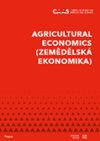利用农业资源生产生物燃料的空间平衡分析
IF 1.8
4区 经济学
Q2 AGRICULTURAL ECONOMICS & POLICY
引用次数: 0
摘要
为了减轻气候变化的潜在危害,并履行《巴黎协定》(COP 24)的要求,中国颁布了对乙醇混合汽油的强制性规定,以减少目前的二氧化碳排放水平。由于大规模生物能源开发涉及原料选择(能源作物、作物废弃物)、技术替代(常规和纤维素乙醇、热解)、政府补贴(土地利用、能源作物补贴)、碳交易机制等多个方面,因此需要综合分析经济、环境和社会效应,探索最优的生物燃料战略和社会效应。本研究提出了一个价格内生的部分均衡数学规划模型,以研究生物能源作物和生物能源技术的选择如何影响生物能源净产量、碳固存、政府补贴和种植模式。我们表明,农业废弃物的联合利用可以有效地补充当前的生物燃料生产。研究结果还表明,在汽油和排放价格较高的情况下,用于能源作物项目的更多土地会导致政府支出的显著变化。此外,当采用不同的生物能源技术时,净减排和排放抵消效率可能有很大差异。本文章由计算机程序翻译,如有差异,请以英文原文为准。
A spatial equilibrium analysis of using agricultural resources to produce biofuel
In order to alleviate the potential damage from climate change and fulfil the requirements contracted in the Paris Agreement (COP 24), China has promulgated the mandatory regulation on ethanol-blend gasoline to reduce current levels of CO2 emissions. Since large-scale bioenergy development involves various aspects such as feedstock selection (energy crops, crop wastes), technology alternatives (conventional and cellulosic ethanol, pyrolysis), government subsidy (land use, energy crop subsidy) and carbon trade mechanism, an analysis that integrates economic, environmental, and social effects is necessary to explore the optimal biofuel strategy and social effects. This study proposes a price endogenous, partial equilibrium mathematical programming model to investigate how the selection of bioenergy crops and bioenergy technologies influences the amount of net bioenergy production, carbon sequestration, government subsidies, and cultivation patterns. We show that the conjunctive use of agricultural wastes can be an effective addition to current biofuel production. The results also indicate that at high gasoline and emissions prices, more land used for the energy crop program results in a significant change in government expenditure. In addition, net emissions reduction and emissions offset efficiency can vary substantially when different bioenergy techniques are adopted.
求助全文
通过发布文献求助,成功后即可免费获取论文全文。
去求助
来源期刊

Agricultural Economics-Zemedelska Ekonomika
Agricultural Economics & Policy-
CiteScore
4.30
自引率
4.50%
发文量
47
审稿时长
30 weeks
期刊介绍:
An international peer-reviewed journal published under the auspices of the Czech Academy of Agricultural Sciences and financed by the Ministry of Agriculture of the Czech Republic. Published since 1954 (by 1999 under the title Zemědělská ekonomika).Thematic scope:
original scientific papers dealing with agricultural subjects from the sphere of economics, management, informatics, ecology, social economy and sociology. Since 1993 the papers continually treat problems which were published in the journal Sociologie venkova a zemědělství until now. An extensive scope of subjects in fact covers the whole of agribusiness, that means economic relations of suppliers and producers of inputs for agriculture and food industry, problems from the aspects of social economy and rural sociology and finally the economics of the population nutrition. Papers are published in English.
 求助内容:
求助内容: 应助结果提醒方式:
应助结果提醒方式:


